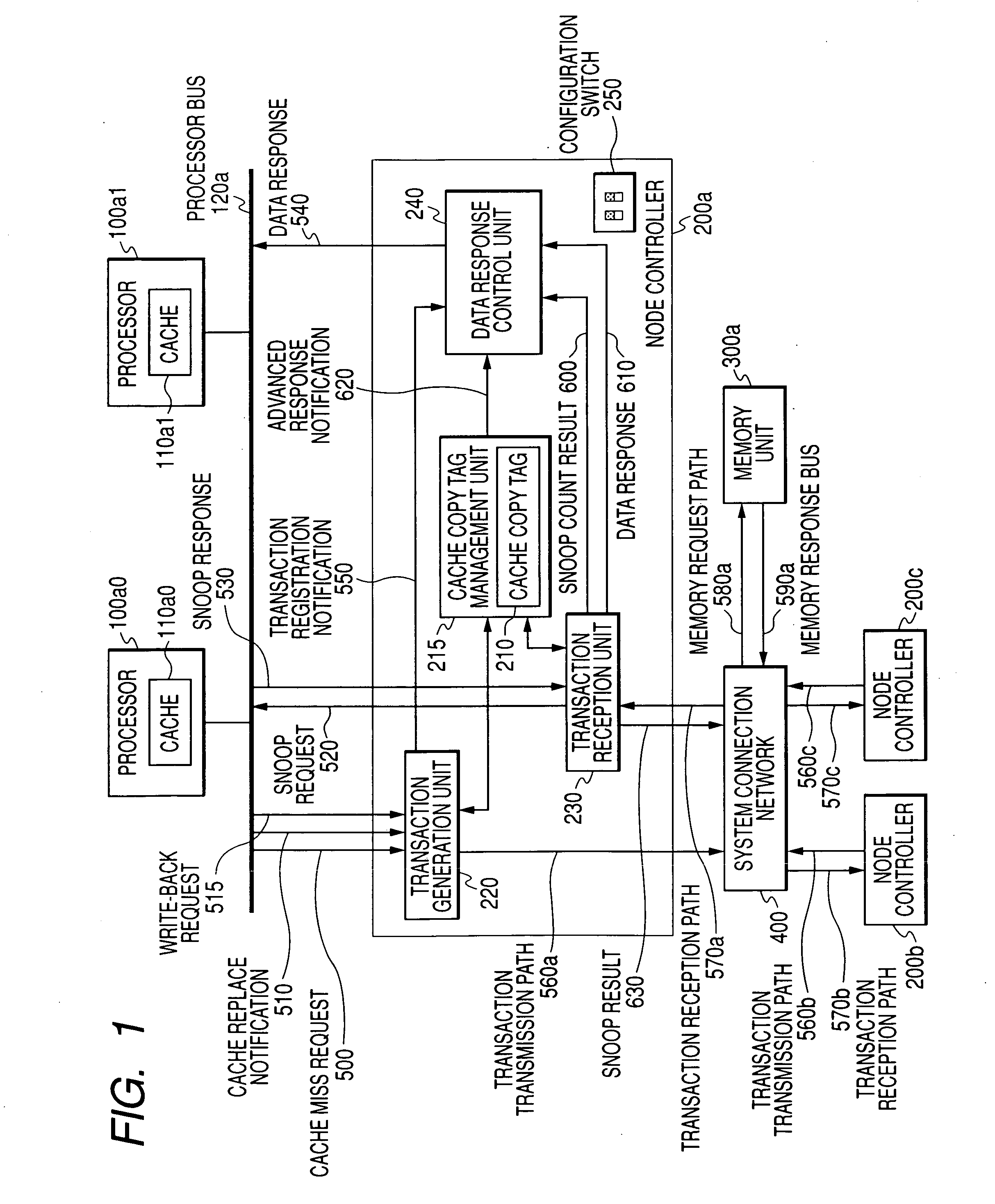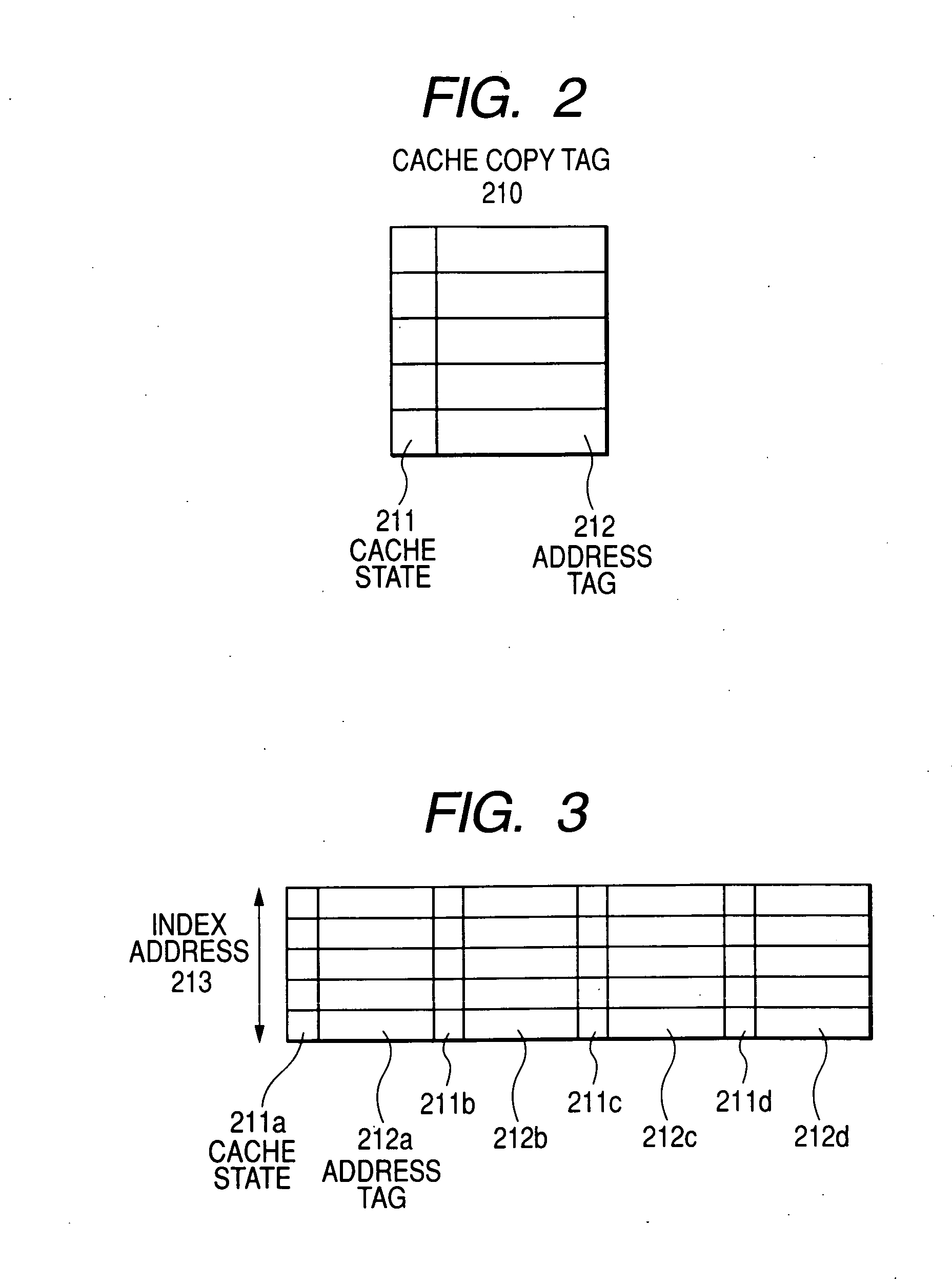Cache coherency control method, chipset, and multi-processor system
a coherency control and cache technology, applied in the field of multi-processor systems, chipsets, and cache coherency control methods, can solve the problems of ccnuma can more hardly demonstrate the performance than, the difference between the time to access memory in one node, and the performance of improving performance, so as to improve the memory access latency
- Summary
- Abstract
- Description
- Claims
- Application Information
AI Technical Summary
Benefits of technology
Problems solved by technology
Method used
Image
Examples
embodiment 1
[0043]Overview
[0044]FIG. 1 is a schematic diagram showing a multi-processor system composed of a node controller having a cache coherency control function as embodiment 1 of the invention.
[0045]One or more node controllers 200 and memory units 300 are connected to each other via a system connection network 400. The memory unit 300 may be provided in the same node as the node controller 200 or on a system board. That is, a node controller 200a and a memory unit 300a construct a node. A node controller 200b and a memory unit 300b construct another node. Though not shown explicitly in FIG. 1, the memory unit 300 is composed of a memory controller and a main storage. Though not shown in FIG. 1, an I / O unit is connected via the node controller 200 or the system connection network 400. Multiple I / O devices are connected to the I / O unit. The node controller 200 connects with one or more processors 100 via the processor bus 120. The processor 100 includes a cache 110. While the embodiment u...
modification 1
of Embodiment 1
[0087]The cache miss request according to modification 1 operates similarly to embodiment 1. On the other hand, the cache replacement process according to modification 1 operates slightly differently from embodiment 1. That is, the cache copy tag management unit 215 is notified of the cache replacement from the transaction generation unit 220. At this time, the cache copy tag management unit 215 is also notified of a node that includes memory having an address targeted for the cache replacement. When the targeted address points to a remote node, the process updates the cache copy tag similarly to embodiment 1 as mentioned above. When the targeted address points to the local node, the process does not update the cache copy tag. Modification 1 of embodiment 1 has now been described.
[0088]FIG. 19 shows a flowchart of the cache replacement process according to modification 1. This flowchart can replace the flowchart in FIG. 18. When a cache replacement request occurs, the...
modification 2
of Embodiment 1
[0090]The construction of modification 2 is mostly common to that of embodiment 1, i.e., as shown in FIG. 1. According to modification 2, however, the configuration switch 250 of the node controller 200 includes a cache replacement cache replacement cache replacement control switch 270. The cache replacement cache replacement cache replacement control switch 270 enables or disables the replacement.
[0091]The cache copy tag management unit 215 is notified of cache replacement from the transaction generation unit 220 and then checks the state of the cache replacement cache replacement control switch 270. When the cache replacement cache replacement control switch 270 enables the replacement, the cache copy tag management unit 215 updates the cache copy tag similarly to the basic example of embodiment 1. When the cache replacement cache replacement control switch 270 disable the replacement, the cache copy tag management unit 215 does not update the cache copy tag.
[0092]F...
PUM
 Login to View More
Login to View More Abstract
Description
Claims
Application Information
 Login to View More
Login to View More - R&D
- Intellectual Property
- Life Sciences
- Materials
- Tech Scout
- Unparalleled Data Quality
- Higher Quality Content
- 60% Fewer Hallucinations
Browse by: Latest US Patents, China's latest patents, Technical Efficacy Thesaurus, Application Domain, Technology Topic, Popular Technical Reports.
© 2025 PatSnap. All rights reserved.Legal|Privacy policy|Modern Slavery Act Transparency Statement|Sitemap|About US| Contact US: help@patsnap.com



